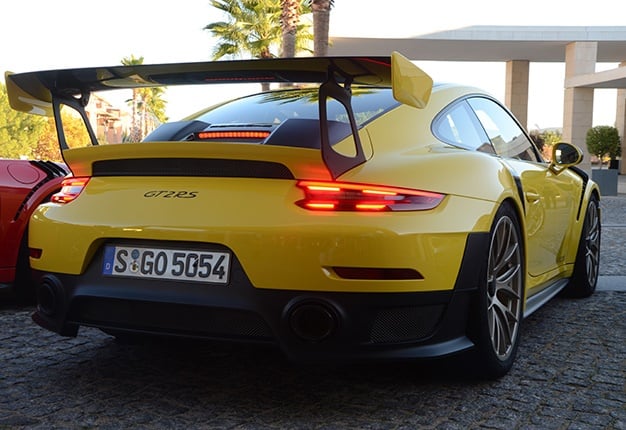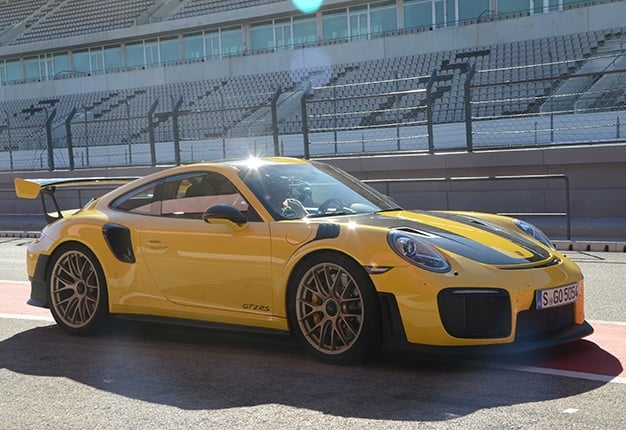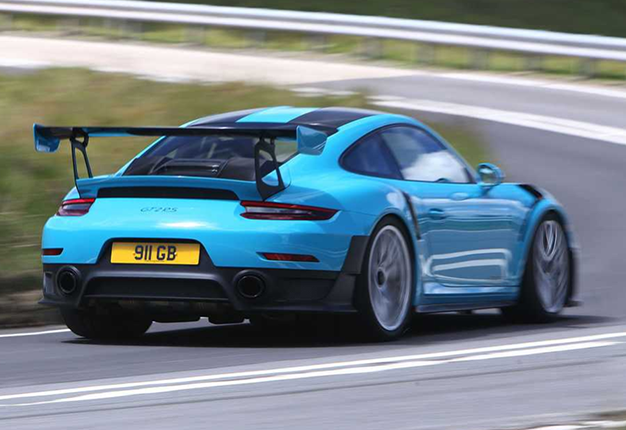
''This Porsche is nobody’s playmate. It’s a triple-X hardcore. As such, it really lords it over the entire iconic 911 family," writes Egmont Sippel as he experiences the Porsche 911 GT2 RS
So, we have this royal family called the Porsche 911 or, if you want, Porsche Neunelfer. It is, all things considered, the most extraordinary sports car series the world has yet seen.
The 911 started off at the 1963 Frankfurt Motor Show as a 96kW tortoise-shaped 2+2 coupé with a 2.0-litre flat-6 'boxer' engine hanging off the rear transaxle.
Still going strong
More than half a century later – with 70% of all units ever built still running! – the 911 is still a tortoise-shaped 2+2 coupé, still with a flat-6 ‘boxer’ hanging off the rear transaxle.
READ: Official: Porsche's GT2 RS sets quickest Nürburgring Nordschleife lap
But it is no longer a 2.0-litre. Nor does it deliver only 96kW or, worse still, 81kW as it did in the short-lived 911 T, or a paltry 66kW in the extreme case of the 1.6-litre four-cylinder iteration of the 911, called 912, issued from 1966-1969.
Nowadays, you can buy a 911 that chomps at the bit with a power multiplication of almost eight, compared to the 912’s. Yep, we’re talking a rip-snorting 515kW.
What do you think of the Porsche 911 GT2 RS? Email us
The 0-100km/h is blitzkrieged in a stupor-inducing 2.8 seconds. Top speed clocks an almighty 340km/h. Torque in this, the final iteration of Porsche’s 9A1 flat-6 snorter, peaks at a stupendous 750Nm.
And it’s all handled by the rear axle and the rear axle only. So, the name is hardly Neunelfer any more. No sir. This car is a monster Big Daddy. I first encountered the monster during its world launch on the Portimão racetrack in southern Spain, late in 2017.
Fire and fury
The GT2 RS simply devours tarmac and distance. If you’re not careful, it will devour the driver as well, which is more or less to be expected when explosive high-octane fuel injected into 3.8 litres of oxygen-rich air charged by two turbos and compressed by a ratio of 9:1 is ignited behind one’s back.
Things go nuclear, even on a race track where the references normally used to measure speed by – like trees, or pedestrians, or cars moving in the opposite direction – just don’t exist.
Image: Net Car Show
Imagine now, what it feels like on a narrow public road. The horizon, so far away, is history in a blink. It swallows you afore ye can think. And it’s not future technology stuff like electricity or magnets operating in near silence either.
The 3.8 bi-turbo is hugely modernized to live on the hi-tech edge of the internal combustion envelope, but deep down it is still just a classically rumbustious old-school unit, consisting of two sets of three cylinders each, furiously boxing away across the car’s spinal axis behind the rear axle.
It all starts off with a deep-throated scowl as the engine bursts into life, before settling into a barrel-chested rumble that quickly morphs into a full-metal scream as you hook first and chase revs.
So, here’s a message to Donald Trump: Explore the innards of this mill before you threaten Kim Jong-un again with fire and fury. For it’s here that you’ll find and define it, inside this unit, on the way to 7 200rpm.
It’s here where cams and valves and pistons and conrods and a crank go bonkers and eventually berserk. It’s here where orchestrated violence chows the Nürburgring stukkend, ek sê, in a 6 min 47.3 second blitz, before bacon and eggs are served for breakfast.
This machine defines fire and fury and does so loudly. ’Tis war, this cry. This car.
Technical report
OK. So the GT2 RS is outrageously powerful and quick, which makes it quite a handful to drive in anger. There’s real venom in the tail, notwithstanding huge oceans of grip and traction, courtesy of the widest tyres ever on a Porsche (265/35-ZR20 fronts, 325/30-ZR21 rears).
The car also rides on a thorough-bred motorsport chassis that eliminates virtually all elasto-kinematics, with rubber bushings giving way to expensive steel ball joints, effecting a particularly firm connection between chassis and body.
Image: Egmont Sippel
Yet, by doubling the spring rate of the GT3 and halving the roll bar stiffness, even a firm ride displays surprisingly compliant edges; quite a masterstroke.
The most powerful and quickest road-legal Porsche yet – with a prodigious set of Brembos to arrest all of this fury when necessary – also boasts extensive weight saving measures: a magnesium roof and titanium muffler; nylon door straps and carbon fibre bucket seats; polyurethane aprons and gorilla glass; a carbon bonnet and wing; an aluminium-steel composite structure; a front lid, front wings, wheel arch vents, air intakes and many interior components from CFRP; and no rear seats, air con, PCM or drive to the front wheels, whilst the optional Weissach package saves a further 30kg via a titanium instead of steel roll cage, magnesium wheels (in a white-gold satin finish) and a rear axle, front anti-roll bar and coupling rods from carbon.
Image: Egmont Sippel
Even carpet cut-outs save 0.2kg, likewise carbon paddle shifters; all in the name of improving acceleration, turn-in and retardation, whilst traction and stability are enhanced by a full-house of Porsche techno-wizardry (PCCB, or Porsche Ceramic Composite Brakes, PASM, PSM and PTV Plus).
Gear changes are lightning quick, courtesy of an absolutely brilliant 7-speed ZF supplied PDK box (the first double-clutch on a GT2 RS), whilst drivetrain responses have been sped up by running a single-mass flywheel.
Aero, for its part, incorporates a huge diffuser and that humongous rear wing, plus hidden steel wires to keep the front splitter from sagging at top end speeds; 370km/h would have been possible if V-max had not been tyre-limited to 340km/h.
The GT2 RS is nobody’s playmate.
Engine and turbos
So, How did Weissach do it? The first step was to try and tap an extra 60kW or so from the engine of the donor car, the 911 Turbo/Turbo S, without expanding swept volume.
Image: Egmont Sippel
So, how about increasing the size of two BorgWarners supplied turbos from 48mm turbine/58 mm compressor to 52mm turbine/64 mm compressor, and update the pistons, crank, main bearing seats and exhaust?
When Porsche found that such a 485kW version of the 9A1 flat-6 comfortably handled all the required numbers in terms of airflow, temperatures and pressures, they started to dream of 515kW, or more specifically the magical threshold of 700PS in terms of horsepower.
Could it be done?
Calculations demanded still bigger BorgWarners – 55mm turbines/67mm compressors, necessitating a lesser compression ratio of 9.0:1, dropped from the Turbo S’s 9.8:1 – but with it Porsche also needed to get more air to the engine, which is difficult in a 911, as the unit locates right at the rear of the car.
Image: Egmont Sippel
Weissach, therefore, installed NACA ducts on the bonnet to feed a new airbox with five tubular filter elements for a maximum surface area, which increased airflow by 15 to 20%.
Heat-related problems
Even so, three heat-related problems surfaced. The first had to do with the size and nature of the turbos. Unlike fixed vane units – that can live with a petrol engine’s highest exhaust gas temperatures (EGT) of 1050 degrees C – variable geometry turbos (VGTs) are so complex and delicate that they can usually only handle 850 degrees C, making them the turbo of choice on diesel mills, where EGTs peak at 800-830 degrees C.
Image: Egmont Sippel
Now, the GT2 RS ain’t exactly an oil burner. For the sake of its two VGT BorgWarner's boosted to 1.55 bar each, a solution, therefore, had to be found to lower the engine’s EGT.
This was done via a cooler combustion chamber mixture, courtesy of a longer air intake distribution pipe with a smaller diameter, in combination with shorter intake manifolds, which delivers better air vibration for enhanced ignition.
The end result is EGTs of 980 degrees C which, uniquely, can be handled by the GT2 RS’s new VGTs.
Spraying intercoolers, new turbo location
That’s the upstream part of the gas/air equation solved. On the downstream side of the chargers, an intercooler rids the air charged back into the cylinders from the heat generated when ambient air is compressed.
The 3.8 would have been unable, however, to deliver a continuous and constant 700PS if charge air cooling had to rely on the intercoolers being fed by an airstream only.
Image: Twitter/What Car
To lower the charge air temperature significantly, with the concomitant increase in air – and thus oxygen – density delivered to the combustion chamber, Weissach employed an old but neat Subaru and Mitsubishi trick of spraying the intercoolers with distilled water whenever charge air temperatures exceed 50 degrees C and the driver uses 90%-plus throttle above 3 000rpm.
The distilled water (so as not to calcify the intercooler) holds in a five-litre reservoir underneath the storage compartment in the 911’s nose. That’s two out of three heat-related problems for the 700PS version of the 3.8-liter bi-turbo solved.
Relocating the turbos
The final problem had to do with the flat-6 configuration of the engine itself and the space it left between a bank of three cylinders on each side of the car’s spinal cord, and the wheels.
On the 911 Turbo/S the 58mm chargers are positioned on either side of the flat-6, between the engine and the wheels. But the 67mm BorgWarners didn’t work in that position.
Image: Porsche
Foam stuffed into the arches of GT2 RS mules showed that the rear tyres, when expanded, chafed the bigger turbos, which meant that Porsche had to reposition them, further backwards, behind the line of the rear wheels.
Does it work? Oh boy! Do they deliver some magic indeed, those big BorgWarners in Big Daddy’s big wide tail carrying a big bad-ass Boeing wing!
Or wait: The ducts on the bonnet might be called NACA. This wing is more akin to NASA.
Conclusion
Add it all up, and Big Daddy decimates performance metrics as we know it. Be sure though, that you have the talent to take the GT2 RS to its limits. It might be a thoroughbred, and thoroughbreds demand respect.
But it is also a monster, and monsters can devour. You’re not dealing with a GTS here, where you can be flat sticks out of the box.
Image: Net Car Show
No. In terms of sheer explosive balls-out track-ready performance, beguilingly wrapped up in everyday usability, the GT2 RS towers above anything else that would like to play the supercar-next-door game.
This Porsche is nobody’s playmate. It’s hardcore triple-X. As such, it really lords it over the entire iconic 911 family. It is the alpha male. It owns the moniker. It wears the crown.
It is the true king of Zuffenhausen’s royal bloodline known as Neunelfer.




 Publications
Publications
 Partners
Partners



















